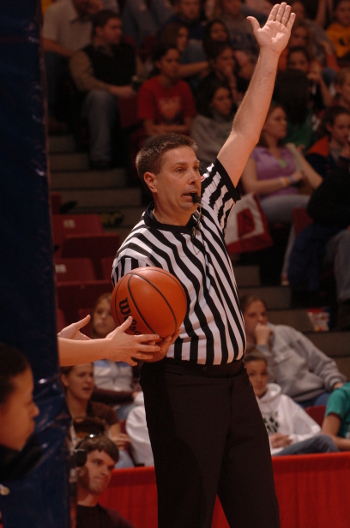"I'm Not Ready": How Officials Can Manage Pace of Play
By Dave Sheets on September 25, 2015 officials Print
Pam stands at the end line with the basketball, trying to hand it to a player for a throw-in. Seconds pass and the player doesn’t take the ball. “I’m not ready,” says the player.
Kevin has said “play ball” and the pitcher seems to be checking the sign. The batter steps out to readjust his gloves. It happens again. Kevin tells the batter to step in and the batter replies, “I’m not ready.”
Mike receives the notice from his umpire that 45 seconds of this timeout are over and it’s time to get back to football. As the referee, Mike announces that the ball is going in play and prepares to signal the 25-second clock should begin. The head coach steps out and says, “We’re not ready.” Mike informs the coach the timeout is over but the coach responds by saying he will let Mike know when he’s ready.
Brian stands on the platform above the volleyball net and calls for a serve. The receiving team captain, from the middle of the court says, “We’re not ready,” as the ball flies her way.
These are just some situations facing officials in high school athletes. How do we know if a player or team is ready? How much time is enough time for them to get ready? How many times during the contest do they get to tell an official they are not ready? Do the rule books give us the answers to these questions?
When speaking to most veteran officials, this is an area they cover under the “game management” tab. It is nearly impossible to have a definitive answer to these questions or a “one-size-fits-all” solution to these situations.
Let’s first look at baseball. Kevin Wilson is a veteran Indiana baseball umpire and he stated, “By rule, it is an infraction by the pitcher if he fails to pitch or make or attempt a play, including a legal feint, within 20 seconds after he has received the ball.”
As far as the batter is concerned, “He shall not delay the game by failing to take his position promptly in the batter's box within 20 seconds. The batter must keep at least one foot in the batter's box throughout the time at bat.”
Sounds pretty cut and dried from the rule book but we all know it doesn’t quite work that smoothly. Wilson commented, “I can't ever recall having a problem with a pitcher. Batters are notorious for stepping out of the box between pitches to adjust something,” he said. “I will give time to pitcher, catcher or batter as long as I do not think it is deliberate. I have had numerous times over the years when a batter will request time at the last second and I will not grant it. Play on and you live with the results of the pitch.”
Another Hoosier veteran and state finals umpire is Jerry Cox. He deals with many of the same issues while officiating high school softball.
“Most umpires try to keep the game player friendly,” said Jerry. “This is a great place for preventive officiating. Umpires are in close proximity to the catchers and batters and most can pick up a legitimate reason for stoppage of play. While we don’t want to allow the games to be delayed or play to lag, we do need to keep the games as player friendly as possible, as that is what high school sports are supposed to be about.” He concluded by saying, “If a player says ‘I’m not ready’ after she has put herself on the pitching rubber, or in the batter’s box, she is at risk of penalty.”
The volleyball court is often the scene of strong emotion between points. A dance celebration for an “ace” or a quick coming together to focus can often be completed while the ball is being recovered for the next serve. Veteran volleyball officials like Brian Humphrey know that developing a rhythm as the R1 helps the game move and sends a message to the teams to be ready. “I don’t want to rush a team, but allowing a team to delay could be an advantage,” he said. Officials like Humphrey also watch and learn from the players so they can mesh the pace of the players and their own. “Only the official should determine the tempo,” he concluded.
On the football field the opportunities for player delays are plentiful. Un-piling after a play, chasing down an incomplete pass, shuttling in a new offensive or defensive unit, or a timeout offer the players opportunities to move slower than normal. This is also a time when officials running to their spots and moving quickly and deliberately sends a message to the players. According to Mike Hubert, a three-decade officiating veteran of Indiana football, “The rhythm set by the crew is critical. Having the ball in position to be ready to play within seconds is step one. Working to keep that time the same between every down is the biggest challenge facing a referee.” At the same time, as schools move to the “no huddle” style of offense, the officials must be aware of the pace to maintain fairness and safety. The officials need to insure both teams have the chance to “recover” after the previous play. How long is that? Only your crew, in that game, can make that determination.
Finally we return to the basketball court where the player just doesn’t want to start the throw in. When the clock is running and the ball is in play, each team can decide the speed with which they will play the game. Otherwise, the game moves at the official’s pace.
“I played the game and coached the game so I believe I have a good sense of how long it takes to be ready for an inbounds play,” says Pam Shively, a veteran basketball official in Indiana. “You can sense when there is confusion by a team or when they are deliberately trying to slow or delay the pace. Using your voice to get the players moving is a valuable tool,” she said. Most players will follow your lead if you are consistent in your actions and your hustle. “Rarely is there an issue more than once with a player not being ready,” said Shively. “However, getting coaches to be ready at the conclusion of the timeout is another discussion all together.”
Reading and understanding the rules can be the easiest part of officiating. Application of the rules and the value of game management are issues that separate the top officials from their peers. For many veteran officials the answer to the questions we asked is, “I know it when I see it.” These are topics and questions to cover in local association meetings and certainly in any pre-contest conference among the officiating crew.
Think about and study these situations prior to stepping into the contest. When a player says, “I’m not ready,” you must be ready!
Dave Sheets
Dave Sheets is the chair of the NFHS Officials Publications Committee, and longtime Indiana official.
Most Recent Articles
- nfhs news NFHS Learning Center Delivers 25 Millionth Course
- Track & Field/Cross Country article Effective Communication with Athletes and Coaches
- nfhs news Player Equipment Changes Highlight 2025 High School Football Rules Revisions
- Player Equipment Changes Highlight 2025 High School Football Rules Revisions
- nfhs news Judgment Call on Second Contact Eliminated in High School Volleyball






